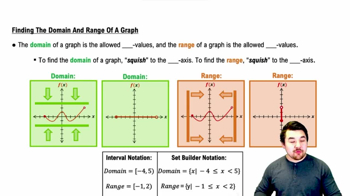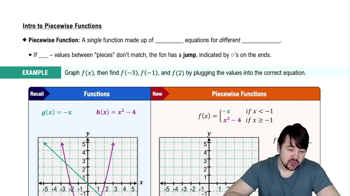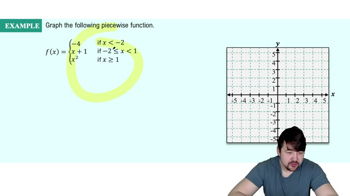Table of contents
- 0. Functions7h 52m
- Introduction to Functions16m
- Piecewise Functions10m
- Properties of Functions9m
- Common Functions1h 8m
- Transformations5m
- Combining Functions27m
- Exponent rules32m
- Exponential Functions28m
- Logarithmic Functions24m
- Properties of Logarithms34m
- Exponential & Logarithmic Equations35m
- Introduction to Trigonometric Functions38m
- Graphs of Trigonometric Functions44m
- Trigonometric Identities47m
- Inverse Trigonometric Functions48m
- 1. Limits and Continuity2h 2m
- 2. Intro to Derivatives1h 33m
- 3. Techniques of Differentiation3h 18m
- 4. Applications of Derivatives2h 38m
- 5. Graphical Applications of Derivatives6h 2m
- 6. Derivatives of Inverse, Exponential, & Logarithmic Functions2h 37m
- 7. Antiderivatives & Indefinite Integrals1h 26m
- 8. Definite Integrals4h 44m
- 9. Graphical Applications of Integrals2h 27m
- 10. Physics Applications of Integrals 2h 22m
0. Functions
Piecewise Functions
Problem 89c
Textbook Question
{Use of Tech} Sum of squared integers Let T (n) = 1² + 2² + ... + n², where n is a positive integer. It can be shown that T (n) = n (n + 1) (2n + 1) / 8
c. What is the least value of n for which T(n) > 1000?
 Verified step by step guidance
Verified step by step guidance1
Step 1: Understand the problem. We need to find the smallest positive integer n such that the sum of the squares of the first n integers, T(n), is greater than 1000. The formula for T(n) is given as T(n) = \( \frac{n(n + 1)(2n + 1)}{6} \).
Step 2: Set up the inequality. We want T(n) > 1000, so substitute the formula into the inequality: \( \frac{n(n + 1)(2n + 1)}{6} > 1000 \).
Step 3: Clear the fraction by multiplying both sides of the inequality by 6 to get: n(n + 1)(2n + 1) > 6000.
Step 4: Solve the inequality. This involves finding the smallest integer n that satisfies the inequality. You can start by testing integer values of n to see when the inequality holds true.
Step 5: Verify your solution. Once you find a candidate for n, substitute it back into the original formula for T(n) to ensure that T(n) > 1000.
 Verified video answer for a similar problem:
Verified video answer for a similar problem:This video solution was recommended by our tutors as helpful for the problem above
Video duration:
4mPlay a video:
Was this helpful?
Key Concepts
Here are the essential concepts you must grasp in order to answer the question correctly.
Sum of Squares Formula
The sum of the squares of the first n positive integers is given by the formula T(n) = n(n + 1)(2n + 1) / 6. This formula allows for the efficient calculation of the sum without needing to manually add each squared integer, which is particularly useful for large values of n.
Recommended video:

Introduction to Riemann Sums
Inequalities
An inequality is a mathematical statement that compares two expressions, indicating that one is greater than, less than, or not equal to the other. In this context, solving T(n) > 1000 requires finding the smallest integer n such that the sum of squares exceeds 1000, which involves manipulating the inequality to isolate n.
Recommended video:

Finding the Domain and Range of a Graph
Integer Solutions
In many mathematical problems, especially those involving sums or sequences, we often seek integer solutions. For this question, we need to find the least positive integer n that satisfies the inequality, which may involve testing successive integer values or using numerical methods to find the threshold where T(n) first exceeds 1000.
Recommended video:

Sigma Notation
Related Videos
Related Practice





